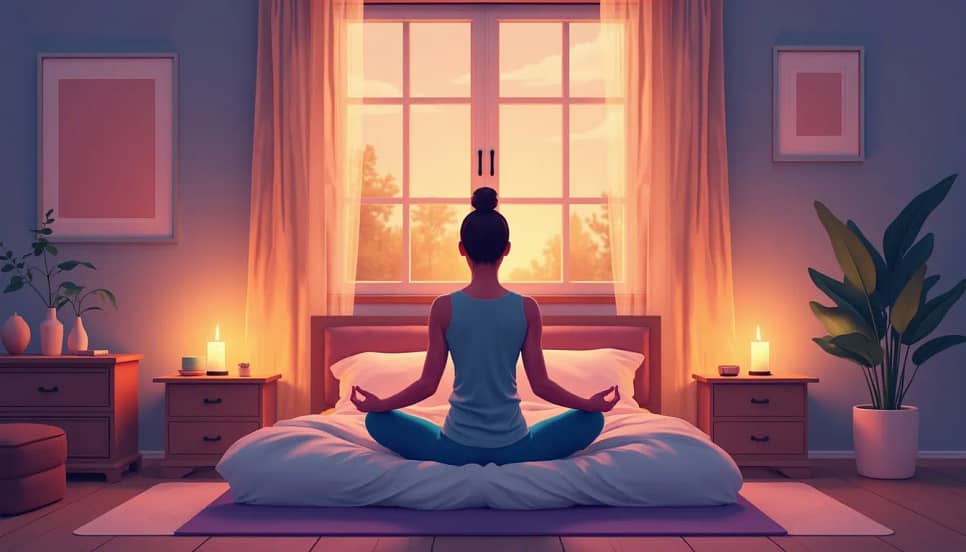In today’s fast-paced world, consider joining a yoga group that specializes in sleep interventions. Consider joining a yoga group that specializes in sleep interventions. Finding a peaceful night’s sleep can be challenging for many, particularly for women with sleep challenges. Sleep issues have become increasingly common with the pressures of daily life, from work to family obligations. But what if there was a natural, holistic way to improve your sleep quality? Enter yoga—a practice that enhances physical health and promotes mental and emotional well-being. This gentle discipline, with its various types and approaches, has been a sanctuary for people seeking balance and tranquility. You can create a serene bedtime routine that prepares your body and mind for restful slumber through specific yoga poses, breathing techniques, and mindfulness practices.
Yoga has been practised for thousands of years, and modern science now supports its benefits. Numerous studies have shown a direct connection between regular yoga practice and improved sleep quality. For instance, research indicates that yoga can decrease the time it takes to fall asleep, increase the length of sleep, and enhance overall sleep satisfaction. This is especially significant given the statistics on sleep disorders: millions of people worldwide struggle with insomnia, which can be alleviated through yoga interventions specifically designed for sleep. and its effects on sleep quality and insomnia in women and other sleep-related issues. Yoga stands out as a beacon of hope, offering a natural remedy without the side effects associated with medication.
In this beginner’s guide, we will explore how yoga can become integral to your journey to better sleep. We’ll delve into calming poses that you can easily incorporate into your evening routine, such as Child’s Pose and Legs Up the Wall. Additionally, we’ll introduce you to breathing techniques like Pranayama and simple meditation practices that further encourage relaxation. Developing a consistent yoga routine tailored for sleep improvement can pave the way to more restful nights and energized days. Whether you’re new to yoga or looking to deepen your practice, this guide provides practical tips to seamlessly integrate yoga for sleep into your daily life. From starting with simple poses to creating a conducive environment for practice, you’ll find all the support you need to make yoga a nurturing part of your sleep routine.
Introduction to Yoga and Sleep
Overview of Yoga: Definition and Types
Yoga is an ancient practice encompassing physical postures, breathing exercises, meditation, and ethical principles to promote holistic well-being. Originating from India, yoga’s diverse traditions have flourished globally, evolving into various styles that cater to different needs and preferences. Yoga aims to create a harmonious balance between the mind, body, and spirit, leading to enhanced physical health and mental clarity.
Some popular types of yoga include:
- Hatha Yoga: Focuses on basic postures and breathing techniques, suitable for beginners.
- Vinyasa Yoga: A dynamic form of yoga that connects breath with movement, offering a flowing sequence of poses.
- Yin Yoga is particularly beneficial for enhancing sleep efficiency. A slow-paced style that emphasizes deep stretching and holding poses for extended periods, ideal for relaxation.
- Restorative Yoga: Uses props to support the body in gentle postures, promoting deep relaxation and recovery.
- Ashtanga Yoga: A rigorous, structured practice that involves synchronizing breath with a series of progressive postures.
- Iyengar Yoga: Focuses on precision and alignment in poses, often incorporating props to aid in practice.
The Connection Between Yoga and Sleep Quality
The link between yoga and improved sleep quality is well-documented, emphasizing the practice’s role in preparing the body and mind for restful slumber. Yoga encourages the release of physical tension and calms the nervous system, which are crucial elements in transitioning from wakefulness to sleep. The practice fosters mindfulness and present-moment awareness, helping to quiet the mental chatter that often disrupts the ability to fall and stay asleep.
Through intentional movement and breath regulation, yoga engages the parasympathetic nervous system, also known as the rest and digest mode, which counteracts the stress-induced fight or flight response. This physiological shift not only reduces stress but also normalizes circadian rhythms, enhancing the natural sleep-wake cycle.
Statistics on Sleep Issues and Improvement through Yoga
Sleep disturbances are a common issue, affecting millions of individuals worldwide. According to the American Sleep Association, 50-70 million US adults experience some form of sleep disorder, with 30% reporting short-term issues and 10% chronic insomnia. Poor sleep quality significantly impacts daily functioning, mental health, and overall quality of life, leading many to seek natural remedies and interventions.
Studies underscore the efficacy of yoga in addressing sleep problems:
- A 2019 study published in the Journal of Clinical Sleep Medicine found that participants who engaged in regular yoga practice experienced significant improvements in their sleep quality and duration.
- Research from Harvard Medical School revealed that 55% of yoga practitioners reported improved sleep, and 85% highlighted reduced stress levels.
- The National Center for Complementary and Integrative Health (NCCIH) reports that yoga and meditation can help alleviate insomnia and promote deeper, more restorative sleep.
These statistics illuminate the potential of yoga as a powerful tool for enhancing sleep quality. Incorporating yoga into your nightly routine could transform your sleep patterns, providing the rejuvenation needed for vibrant health and well-being.
By integrating yoga into your lifestyle, you invite a natural, holistic remedy to improve sleep, reduce stress, and connect with your inner peace. As you explore this practice, remember that each journey is unique, and every small step brings you closer to the tranquility you seek. Let the gentle flow of yoga guide you into a restful night and a more balanced life.

Yoga Poses and Practices for Better Sleep
Calming Poses for Evening Routines: Child’s Pose, Legs Up the Wall
As the day winds down, fostering a calming routine can help signal your body that it is time to rest. One of the most beneficial ways to do this is through specific yoga poses that promote relaxation and tranquility. Let’s explore two soothing poses to integrate into your evening routine.
Child’s Pose (Balasana)
Child’s Pose is a gentle, restorative pose that helps you relax and unwind. To perform Child’s Pose:
- Kneel on the floor and sit back on your heels.
- Extend your arms forward, lowering your chest to rest between your thighs.
- Gently rest your forehead on the floor.
- Breathe deeply and hold this position for a few minutes, feeling your body release tension.
This pose stretches the back and shoulders, easing physical stress and promoting a sense of calm.
Legs Up the Wall (Viparita Karani)
Legs Up the Wall is another wonderfully relaxing pose that helps alleviate tired legs and promotes better circulation. Here’s how to do it:
- Sit with one side of your body against a wall.
- Gently turn to lie flat on your back and extend your legs up the wall.
- Ensure your lower back remains close to the floor, creating a 90-degree angle with your legs against the wall.
- Place your arms at your sides, palms facing up, and close your eyes.
- Hold for five to fifteen minutes, breathing slowly and mindfully.
This pose is excellent for reducing lower back tension and swelling in the legs, helping you feel more comfortable and ready to transition to sleep.
Breathing Techniques and Mindfulness: Pranayama and Meditation
Beyond physical poses, incorporating breathing techniques and mindfulness practices can significantly enhance your sleep quality. These methods help calm the nervous system and create a sense of inner peace.
Pranayama (Breathing Exercises)
One powerful breathing technique for relaxation is “Nadi Shodhana” or alternate nostril breathing:
- Sit comfortably with a straight spine.
- Close your right nostril with your right thumb.
- Inhale deeply through your left nostril.
- Close your left nostril with your ring finger and release your right nostril.
- Exhale through your right nostril.
- Inhale through your right nostril, then close the right nostril and exhale through the left.
Repeat this pattern for a few minutes. This practice can help balance your energy and reduce anxiety, making it easier to fall asleep.
Meditation
Meditation is another effective tool for quieting the mind and enhancing sleep quality and insomnia. A simple meditation technique to try before bed is:
- Find a comfortable seated position or lie down.
- Close your eyes and take a few deep breaths.
- Focus on your breath, noticing the rise and fall of your chest or abdomen with each inhale and exhale.
- If your mind wanders, gently bring your attention back to your breath without judgment.
- Continue this practice for five to ten minutes, or until you feel more relaxed and grounded.
Regularly engaging in meditation can improve your ability to manage stress and clear your mind before bedtime, promoting more restful sleep.
Developing a Consistent Yoga Routine for Sleep Improvement
The key to reaping the benefits of yoga for better sleep is consistency. Developing a regular practice can help train your body and mind to relax at the end of the day. Here are some tips to establish a consistent yoga routine:
- Set a Schedule: Choose a specific time in the evening to practice yoga and stick to it. This helps create a habitual routine, making it easier to maintain.
- Create a Peaceful Space: Designate a quiet area in your home for your yoga practice. Use calming elements like soft lighting, soothing music, or essential oils to make the space inviting.
- Start Small: Begin with a short, manageable routine to avoid feeling overwhelmed. As you become more comfortable, gradually increase the duration of your practice.
- Listen to Your Body: Pay attention to how your body feels during each pose. Modify or skip poses if needed, and focus on what feels good for you.
- Combine Yoga with Other Relaxation Techniques: Integrate breathing exercises and meditation into your routine for maximum relaxation and sleep benefits.
By making yoga a regular part of your evening routine, you can create a nurturing environment that supports better sleep and overall well-being.

Tips for Beginners to Incorporate Yoga into Daily Life
As you embark on your journey to incorporate yoga for better sleep, creating an environment and routine that supports your commitment is essential. Here are some compassionate and practical tips to help you, especially if you’re a beginner, to weave yoga into your daily life effortlessly.
Starting Slowly: Simple Poses for New Practitioners
Starting slow is key. As a beginner, taking it one step at a time is perfectly okay. You don’t need to master complex poses right away. Here are a few simple poses to get you started:
- Savasana (Corpse Pose): This pose is about total relaxation. Lie flat on your back with arms resting by your sides, palms facing up. Close your eyes and breathe deeply, allowing your body to sink into the floor. This pose helps release tension and primes the mind for rest.
- Cat-Cow Stretch: Begin on all fours. Inhale as you arch your back down, lifting your head and tailbone (Cow Pose). Exhale, rounding your spine upwards, tucking your chin to your chest (Cat Pose). This gentle flow promotes spinal flexibility and relaxation.
- Supported Child’s Pose: Kneel on the floor, touching your big toes together and sitting on your heels. Extend your arms forward and rest your forehead on the mat. This pose is calming for the nerves and can help you feel grounded.
Practicing these simple poses can naturally ease you into the habit of doing yoga without feeling overwhelmed. Remember to honor where your body is at and celebrate small progress.
Creating a Sleep-Friendly Environment for Yoga Practice
Your environment significantly impacts the quality of your yoga practice, especially when the goal is to improve sleep. Here are some tips to create a calm and inviting space:
- Choose a Quiet Spot: Find a quiet, peaceful corner of your home where you are least likely to be disturbed. This will help you maintain focus and build a consistent practice.
- Dim the Lights: Soft, dim lighting can create a relaxing atmosphere conducive to yoga for sleep. Consider using candles or soft lamps to minimize harsh lighting.
- Use Aromatherapy: Scents like lavender, chamomile, or sandalwood have calming properties. Essential oils, incense, or diffusers can also enhance relaxation.
- Comfortable Gear: Wear loose, comfortable clothing that allows free movement and choose a yoga mat that provides adequate cushioning and support.
- Set a Regular Time: Consistency helps build a habit. Set a specific time for your yoga practice each evening, preferably a couple of hours before bedtime, to signal to your body that it’s time to wind down.
Creating a conducive environment makes your yoga practice more effective and enjoyable, ultimately fostering better sleep quality.
Resources and Classes for Further Learning and Support
It’s perfectly fine to seek guidance as you start your yoga practice. Numerous resources are available to support you, whether you prefer online classes or in-person instruction:
- Online Platforms: Websites like Yoga with Adriene, Glo, and Gaia offer beginner-friendly yoga sequences specifically promoting relaxation and sleep. These platforms often provide trial periods so you can explore and find what resonates with you.
- Mobile Apps: Apps such as Calm, Headspace, and Insight Timer offer guided yoga sessions and meditations that can ease you into tranquility. These apps can be excellent companions, providing practice reminders and session tracking.
- Local Yoga Studios: If you prefer a more communal experience, check out local yoga studios. Many offer beginner classes and may even have specific sessions focused on sleep and relaxation. Engaging with a yoga community can provide additional motivation and support.
- Books and DVDs: Explore books like “The Miracle of Mindfulness” by Thich Nhat Hanh or “Yoga for Better Sleep” by Mark Stephens. These can serve as handy references you can return to as you advance in your practice.
If you encounter challenges or have specific questions, don’t hesitate to contact instructors or join a yoga group focused on sleep improvement. Sharing experiences and seeking advice can be incredibly beneficial and comforting.
By taking these small, mindful steps, you’ll gradually find yoga becoming a natural part of your life. Not only does it enhance sleep quality, but it also brings about a sense of peace and well-being that transcends into your daily routine. Remember, you are on a personal journey, and every small effort contributes to your overall harmony and health.
As we reach the end of our journey exploring how yoga can improve sleep quality, it’s evident how transformative this practice can be. By understanding the essence of yoga and its calming influence on the mind and body, we’ve delved into methods that can significantly enhance our nightly rest. From the welcoming embrace of the Child’s Pose to the soothing elevation of Legs Up the Wall, we’ve discovered poses that gently prepare our bodies for sleep. Additionally, we’ve learned how central breathing techniques like Pranayama and mindfulness meditations profoundly calm the mind, making it easier to drift into a peaceful slumber.
Integrating yoga into daily routines may seem daunting for beginners. However, taking small, manageable steps can lead to significant progress. Begin with simple, accessible poses and gradually build your practice. Consistency is key. Establishing a dedicated space for your evening routine can also bolster your commitment. Ensure your environment is serene and conducive to relaxation, free from distractions.
Moreover, the importance of community and continuous learning cannot be overstated. Whether through online resources, local classes, or connecting with fellow practitioners, a wealth of support is available to guide you.
The benefits of improved sleep extend far beyond just feeling rested. Quality sleep can enhance mood, increase energy levels, and support well-being. Yoga offers a holistic approach, harmonising the mind, body, and spirit.
Remember, the journey of yoga and improved sleep is personal and unique to each individual. Be compassionate with yourself, celebrate your progress, and patiently embrace the process. With dedication and an open heart, you’ll discover the profound impact yoga can have on your sleep and overall quality of life. Take a deep breath, find your center, and let yoga be your guide to restful nights and brighter days.
Frequently Asked Questions
What is the relationship between yoga and sleep quality?
The relationship between yoga exercise and sleep quality is well-documented in various studies. Regular yoga practice can significantly enhance sleep quality by promoting relaxation, reducing stress, and alleviating insomnia symptoms. Through physical postures, breathing techniques, and meditation, yoga helps to calm the mind and body, resulting in a more restful night’s sleep. The effect of yoga on sleep quality can be particularly beneficial for individuals experiencing sleep problems or sleep disturbances.
How can yoga help alleviate insomnia?
Yoga can be an effective method to alleviate insomnia by incorporating relaxation techniques that help to reduce anxiety and stress. Specific yoga poses and breathing exercises can lower cortisol levels, which are often elevated in individuals with insomnia. Practices such as restorative yoga and gentle stretches before bedtime can help you unwind and prepare your body for a good night’s sleep. Many people find that a consistent yoga practice not only helps them to fall asleep faster but also improves overall sleep quality.
What are the best yoga poses for improving sleep quality?
Some of the best yoga poses for improving sleep quality include Child’s Pose, Legs-Up-The-Wall, and Supta Baddha Konasana. These poses promote deep relaxation and help to calm the nervous system. A few gentle stretches and breathing exercises can help you transition into a restful state. Practicing these yoga poses regularly can significantly improve your overall sleep quality and help you combat sleep problems.

